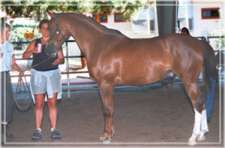 |
|
 |
|
The following article can be found on the Natural Horse website at www.NaturalHorse.com in Volume 2, Issue 6, Article 8, under Special Features. Equine CranioSacral Work - An Introduction to the Physiological and Intuitive UnderstandingBy Maureen Rogers What is CranioSacral Work?
|
|||||||||||||||||||||||||||||||||||||||||||||||||||||||||||||||||||||||||||||||||||||||||||||||||||||||||||||||||||||||||||||||||||
A Brief History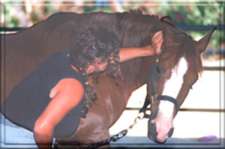 CranioSacral Work, which originated from the work of osteopath Dr. William Sutherland, DO in the early 1900's was originally called 'craniopathy' and was derived from osteopathy. It was later called 'CranioSacral Therapy' by Dr. John Upledger, DO from the Upledger Institute, and 'Visionary CranioSacral Work' by Dr. Hugh Milne, from The Milne Institute. Now the work is being taken over to the equine world with much success. CranioSacral Work, which originated from the work of osteopath Dr. William Sutherland, DO in the early 1900's was originally called 'craniopathy' and was derived from osteopathy. It was later called 'CranioSacral Therapy' by Dr. John Upledger, DO from the Upledger Institute, and 'Visionary CranioSacral Work' by Dr. Hugh Milne, from The Milne Institute. Now the work is being taken over to the equine world with much success.
The Equine CranioSacral System - "The Core Link" The spinal column is protected by what is called the dural tube, which encases the spinal column. The dural tube attaches at the foramen magnum, meaning 'large window' in Latin. This 'window' allows the spinal column to exit the skull through the large opening in the occipital bone, which forms the base of the skull. The dural tube then attaches to cervical vertebra 2, or C2, and free-floats through the length of the spinal column until it attaches again at the second sacral segment of the sacrum, thus attaching the head to the hind end, or the occiput to the sacrum.
Equine CranioSacral Work uses sensitive and exact finger pressure. Pressures are exceedingly gentle and there is no bone manipulation. The measurable amplitude of the cranial wave (a discreet, muscular pulsation delivered by the cranial bone) is between 40 microns to 1.5 mm. in movement according to different authorities, less than half the thickness of dental paper. The movement cannot be seen, but can be palpated in a meditative state. The practitioner's or healer's challenge is thus to sense, listen to, and finally to interpret a very discreet movement. The cranial rhythm (the rhythm of the cranial waves) is said to cycle between 8-14 cycles per minute and can be palpated anywhere on the body. The cranial rhythm is different from that of the heartbeat and the respiratory rate.
Connecting Head to Tail
When an injury or trauma occurs, it gets 'stuck' in the tissue of the horse and is stored in the cell memory of the tissue until released. Dr. Upledger calls this injury an 'energy cyst'. Another term used by some is a 'psychotic corner'. Dr. Hugh Milne refers to it as an 'archaic wound'. A CranioSacral practitioner is taught to sense any restrictions in the CranioSacral system. By palpating the cranial wave on different areas of the horse, a practitioner can tell where there is healthy movement or lack of movement. This is similar to an acupuncturist palpating the flow of energy through meridian pathways. The practitioner or healer learns specific hands-on techniques to palpate the cranial wave anywhere on the horse's body. Also learned are specific hands-on contacts for cranial bones and the bones of the pelvis to treat different conditions of the horse, thus assisting the body to correct itself. The body has an incredible self-healing mechanism, and in the Equine CranioSacral Work, trained practitioners are taught to listen to what the horse needs. The horse's restrictions can come from a physical trauma of any kind, including chemical, as well as an emotional or spiritual trauma. Each affects the other.
Treatable Conditions TMJD (Temporomandibular Joint Dysfunction) is a condition in both humans and horses. Specifically, it is a condition of the TMJD where the mandible or jaw is not free-floating in the joint capsule of the temporal bone, the region by the ear. The muscles around the joint have become tightened due to stress, physical injury, or trauma. TMJ becomes more complicated in horses than in people because horses have movable ears. TMJD affects the horse's performance, the ability for proper nutritional intake, and mental and emotional well-being.
Working with Acute Conditions Vs. Chronic Other modalities that work well with the CranioSacral Work are massage, chiropractic, acupuncture, and acupressure, and equine dentistry. Combing this with playtime and grazing. Keep your horse living longer and healthier by preventive care. Always consult with your veterinarian. Equine CranioSacral Work by no means replaces professional veterinary care. It is important to work with people who are properly trained in Equine CranioSacral Work. Some of the information in this article was adapted from the book, The Heart of Listening - A Visionary Approach to CranioSacral Work by Hugh Milne.
About the author
For more information regarding Equine Craniosacral Work, |
||||||||||||||||||||||||||||||||||||||||||||||||||||||||||||||||||||||||||||||||||||||||||||||||||||||||||||||||||||||||||||||||||||
| Home | Benefits | What's New | Press Releases | Biography | Links | Contact Us | |||
| Articles | Workshops | Workshop Schedule | Workshop Registration | |||
| Headshaking | Equine Assessment | Equine Dentistry | ECS Practitioners | |||
| ECS 1 | ECS 2 | ECS 3 | ECS 4 | ECS 5 | ECS Review | CCS 1 | CCS 2 | |||
Copyright © 2000 -
2025
Maureen Rogers |
Contact Maureen Rogers
All photographs on this website were shot for the exclusive use of the Equine CranioSacral Workshops. |
||



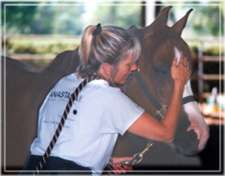 column. CranioSacral work traditionally specialized in the head, spine, and sacrum, but it is not limited to those areas, nor is it limited to the physical. All of the following are considered to make up the "Core Link."
column. CranioSacral work traditionally specialized in the head, spine, and sacrum, but it is not limited to those areas, nor is it limited to the physical. All of the following are considered to make up the "Core Link."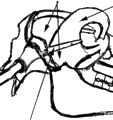



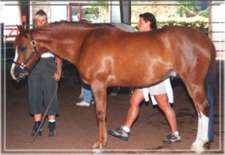
 Sutures, or joints between the cranial bones, allow for movement and help disperse the impact of a blow when an injury to the head occurs. Cranial bones, like all bones, are alive, with a significant amount of blood supply making them pliable. If they weren't, they would shatter on impact, like a china plate.
Sutures, or joints between the cranial bones, allow for movement and help disperse the impact of a blow when an injury to the head occurs. Cranial bones, like all bones, are alive, with a significant amount of blood supply making them pliable. If they weren't, they would shatter on impact, like a china plate.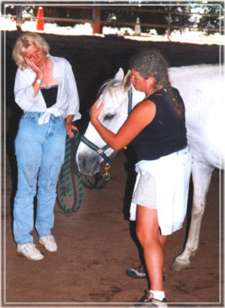 Practitioners watch for signs of the tissue releasing. Signs of a horse releasing during a session may be licking and chewing, yawning, lowering of the head, shifting the weight around on the back feet, stomach gurgling, a change in the breath as in a deep sigh, and softening of the eyes and ears. By releasing these restrictions in the cranial system, healthier function and optimal movement can return to the equine athlete's body.
Practitioners watch for signs of the tissue releasing. Signs of a horse releasing during a session may be licking and chewing, yawning, lowering of the head, shifting the weight around on the back feet, stomach gurgling, a change in the breath as in a deep sigh, and softening of the eyes and ears. By releasing these restrictions in the cranial system, healthier function and optimal movement can return to the equine athlete's body.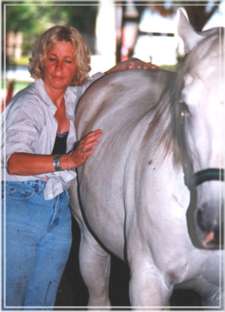 problems and behavioral problems, results of physical abuse, parrot mouth, hind end lameness, colic, tinnitus (ringing in the ears), head shaking, sinus or breathing problems, blocked tear ducts, cribbing, birth traumas, prematurity in foals, castration, and pre-parturition (when pregnant mares are about to give birth), just to name a few.
problems and behavioral problems, results of physical abuse, parrot mouth, hind end lameness, colic, tinnitus (ringing in the ears), head shaking, sinus or breathing problems, blocked tear ducts, cribbing, birth traumas, prematurity in foals, castration, and pre-parturition (when pregnant mares are about to give birth), just to name a few.